In 2019, we performed a large analysis of the flooring industry to give you a complete rundown of the best brands and how they market themselves online. On the final report, we saw that one brand stood out from the rest – Carpetright.
They had a total visibility score of 12,485, we were curious as to what this brand was doing to bring in so much traffic and achieve so much visibility. What were they doing that the other brands weren’t and how can their strategy be replicated so others can achieve similar results?
We jumped straight in and found exactly what Carpetright are doing to get their results, laying out the tactics in a concise and practical way that allows anyone to use them in their own business.
If you’re ready to see what a top player in the flooring does to profit online, read on…
A Mega Menu That Gets Mega Results
One thing you have to get right with your ecommerce store is the mega menu. If it’s confusing or isn’t optimised to the max, you’re missing out on serious rankings.
Carpetright has a comprehensive mega menu which has everything you need from both an SEO and UX perspective. It’s organised into clear-cut categories which make things incredibly easy if you’re looking for a specific product or if you’re a Google-esque robot trying to work out which pages are a priority.
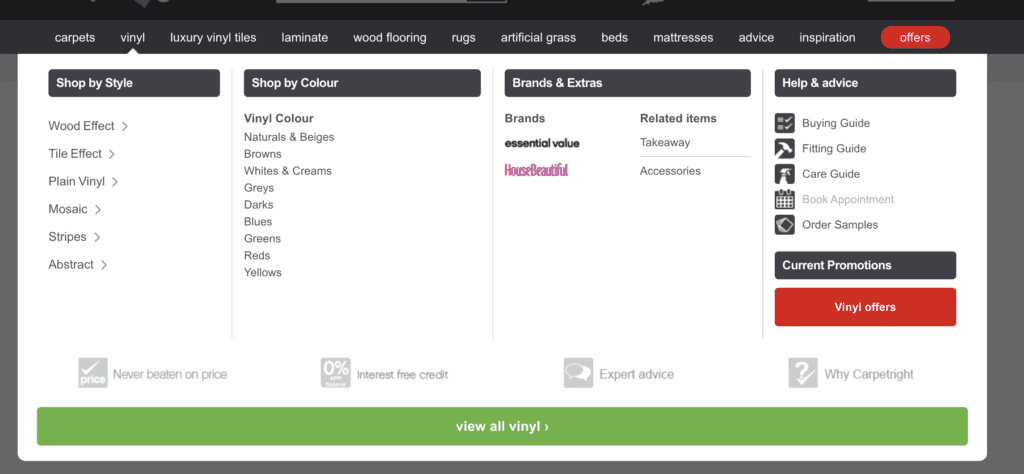
Let’s take a closer look into some of the specific tactics Carpetright are using with their impressive main menu.
The ‘3 click’ Rule
Each of the most important categories expands out in a range of additional options which Google loves to see, making things easy to crawl and reducing crawl budget.
Important pages should be at most three clicks away from the homepage. Any deeper into your site and Google will see them as unimportant and therefore lower their rank – bad practice if one of these pages is a main subcategory!
Carpetright understands this and instead include every possible subcategory, advice, and expert content piece in both the drop-down mega menu and standard navigation. This allows Google to quickly access the pages and understand their importance.
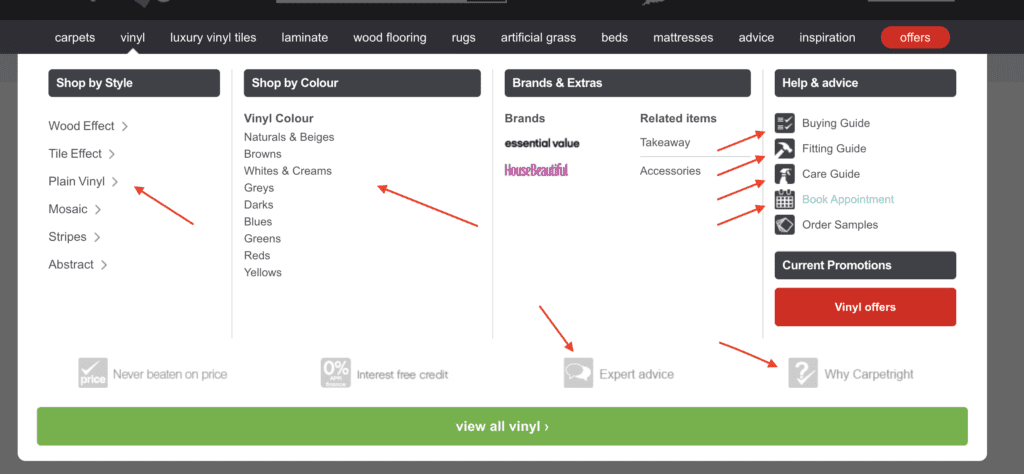
If you find your website is in a slump, it might be because you have hundreds of pages that are not linking well from each other or the home page. Bear in mind Google has to crawl every URL of your site and if you aren’t making it easy your rankings will suffer.
Follow the tactic used by Carpetright and you’ll see boosts in your visibility in no time.
URL Structures that Help Google Think
A common problem we see with ecommerce stores, particularly large ones such as Carpetright, is that the URL structures from the main navigation are often… strange.
When you have a series of random URLs for the array of pages on your store, Google has a hard time understanding what relevance they have to other pages and categories on your site. Thus, it’s important to have a clear structure which follows some sort of semantic pattern.
Carpetright have combined a good balance of using clean URL structures and indexed parameters. Their top-level pages, such as laminate and engineered wood all have simple, clean URL coding which lets Google know exactly what they’re about; there’s no confusion.

They also use parameters instead of individual pages when suitable. This, in effect, reduces the number of pages, optimising crawl budget. They’ve also managed to make sure the site doesn’t spit out strange question marks and ampersands in the coding when parameters are used.

Make sure your ecommerce URL and category structure are neat and tidy. Don’t make Google work any harder than it needs to.
Use Your Keywords Like This…
Some sites fail to utilise their keywords to the fullest. They end up either missing them out completely or stuffing the erratically into their copy (which Google is not too fond of by the way).
Carpetright knows what they’re doing when it comes to keyword implementation and it’s something you see again and again with the top brands in other industries.
They use their main keywords within their main categories, particularly in their H1s.
For example, when you click on the laminate category the first title you see is ‘laminate flooring’. To the average user, this is nothing special. However, to a search engine, this is exactly what they want to see and now know what keyword to instantly rank that page for.
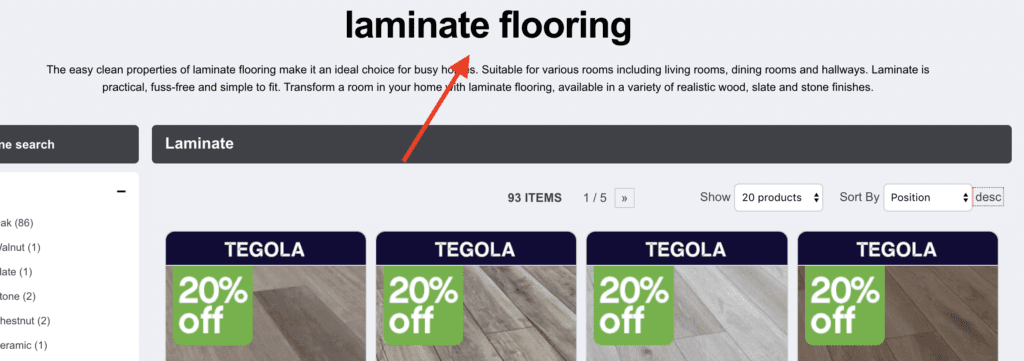
To put this into perspective, the keyword ‘laminate flooring’ gets over 100K searches a month. With Carpetright using keywords like this within the H1s and metadata, they’re giving themselves a better chance at achieving those tops spots for keywords like the above.
A Quick Note About Title Tags
It can be tempting to stuff keywords into your title tags and metadata. Although this can sometimes have positive effects in the short term, it might not benefit you in terms of UX.
Google is paying close attention to click-through rates on the SERPs, so making sure people are clicking on your result tells Google it’s relevant.
Carpetright makes sure their title tags are as ‘clickable’ as possible by adding ‘20% off’ and other benefit-driven phrases. This gives the searcher more of a reason to click on their search result, telling Google it’s relevant and should be higher up the page.

This small hack can be implemented by any brand. It only takes a few seconds and can have drastic results on your visibility.
A Content Strategy You Need to Copy
Content is something Google loves to rave on about…
“Have good content”, “make sure your producing high-quality content”, etc, etc. Yet, they fail to really explain what good content is unless you’re willing to read through the endless documents on their site.
In our experience, good content is well-written, authoritative, and well-referenced. Of course, there are other factors such as keywords, but we won’t touch on those for now.
All you need to know is Carpetright’s content area is superb and has everything needed to tell Google they’re the authority in this industry. Let’s take a quick look at what gets them those much-desired results.
Expert Advice That Creates Authority
Having authoritative content on your website is important in a number of ways. However, primarily, it can help create a sense of expertise, helping people associate you with authority, increasing the likelihood that they’ll purchase from you instead of your competitors.
Carpetright has done a super job at creating consideration-based content. For example, they have buying guides, fitting and installation instructions, and maintenance tips for when making your purchase stand the test of time.
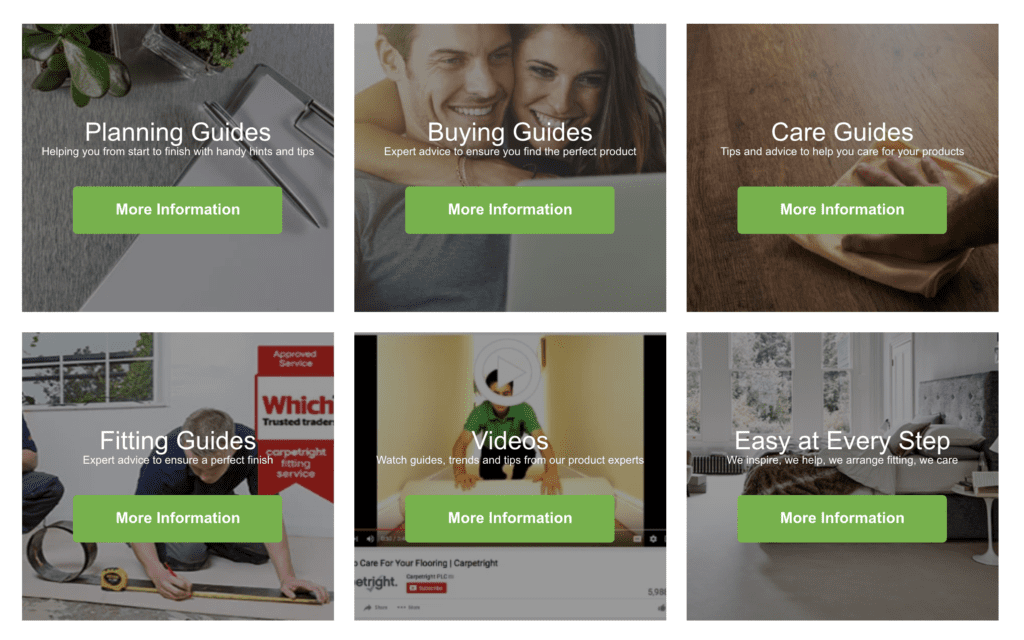
This content not only keeps the attention on Carpetright but also acts as a means to thicken key categories; Google wants to see you bolstering your categories with helpful, practical content which answers users’ questions.
Carpetright’s advice centre gives you everything you need to not only make a reliable buying decision but also makes sure the customers are getting value post-purchase.
If you’re looking to improve category performance and engage more with your customers meaningfully, take a look at their advice centre and mimic their strategy.
Inspiration Content to Inspire Backlinks
As well as practical installation, buying, and maintenance guides, tips on how to design your home and interior are also somewhat related to flooring. If you head over to Carpetright’s inspiration section, you’ll see they’ve picked up on this association as well.

In our experience, inspiration guides and content are an effective way to pick up easy design-based backlinks and to further solidify any authority you have in the marketplace.
Take for example Carpetright’s ‘Meet the Experts’ section which has interior design and flooring tips from experts in the field. They have videos and a wide range of content, presenting Carpetright as the authority in everything flooring.

Some of these guides pick up backlinks as well. Take this example – it has 30 referring domains.
Carpetright have found all the associated topics with flooring and wrote about them in detail. So, take a look at your own industry and do similar. You’ll see many a ranking benefit out of producing guides and increasing the content pool on your site.
Backlinks that Shake the Industry
As mentioned above, Carpetright has the content needed to attract backlinks left, right and centre. However, are there specific pieces of content that get more backlinks than the rest.
Carpetright is not only an authority in the eyes of their customers but also in the eyes of Google. If they weren’t, they probably wouldn’t be achieving the results they are on the SERPs.
Let’s take look at some of the assets they utilise to create impressive backlinks from sites such as The Guardian, The Times, and topic-specific sites such as Apartment Therapy.
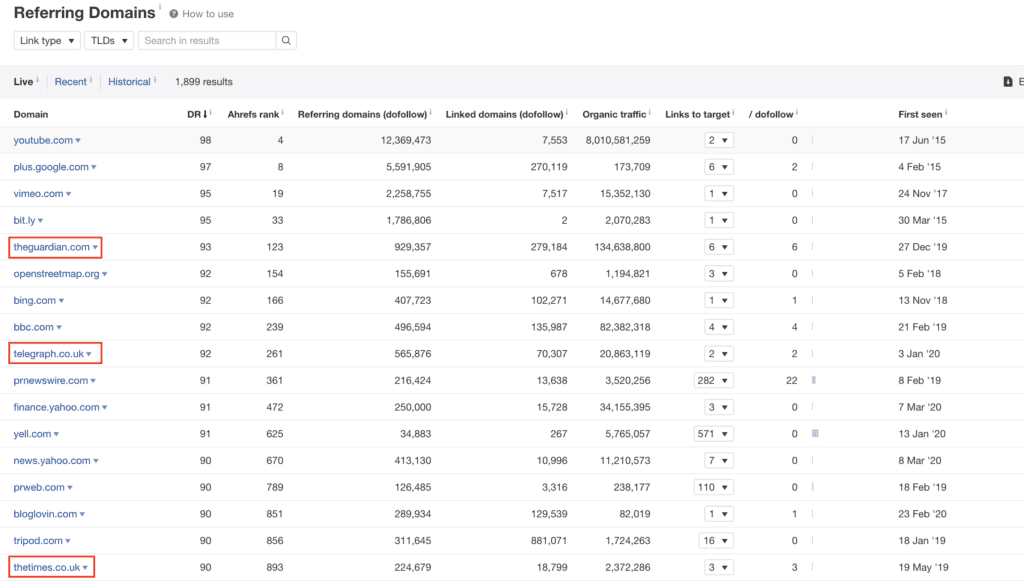
Survey Power
Throughout the history of SEO, surveys have been used as a unique way to achieve backlinks from impressive websites. Carpetright is using them to their advantage with some getting 16 referring domains from sites like The Yorkshire Post and The Scotsman.
Their survey on the envy of neighbours is an excellent example of how a simple question and survey can generate backlinks.
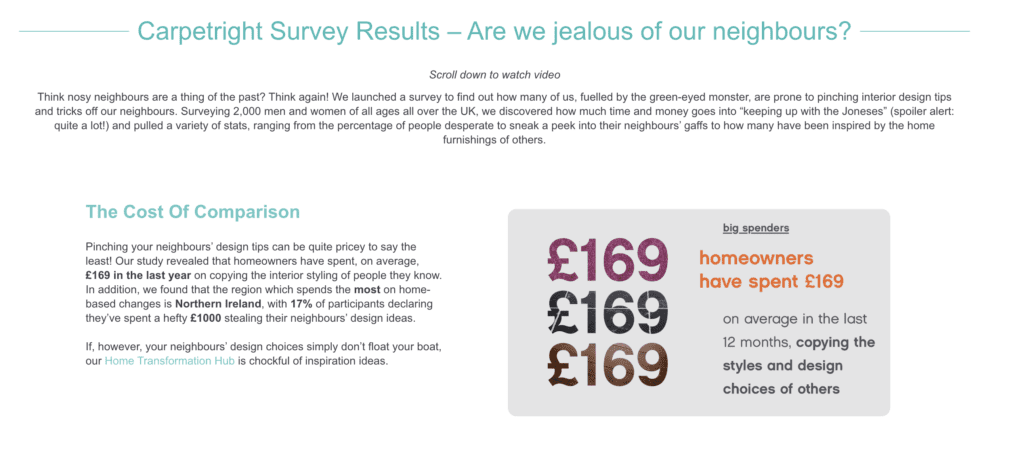
If you can create something novel such as the above example and push it out to your audience, you could be on to a winning asset. If you can’t collect enough data, look internally and see if there is any data you already have that can be turned into an asset.
This is something we did with one of our clients, landing them placements in the Bride Magazine and Sky News.
The Collaboration You Never Knew About
We’ve seen collaborations generate lots of backlinks for other brands in the clothing space but didn’t think to see one being used in the world of flooring. How wrong we were.
One of the most successful assets Carpetright has is a collaboration post with Sleepright Beds, what we can guess to be one of Carpetright’s associated companies.
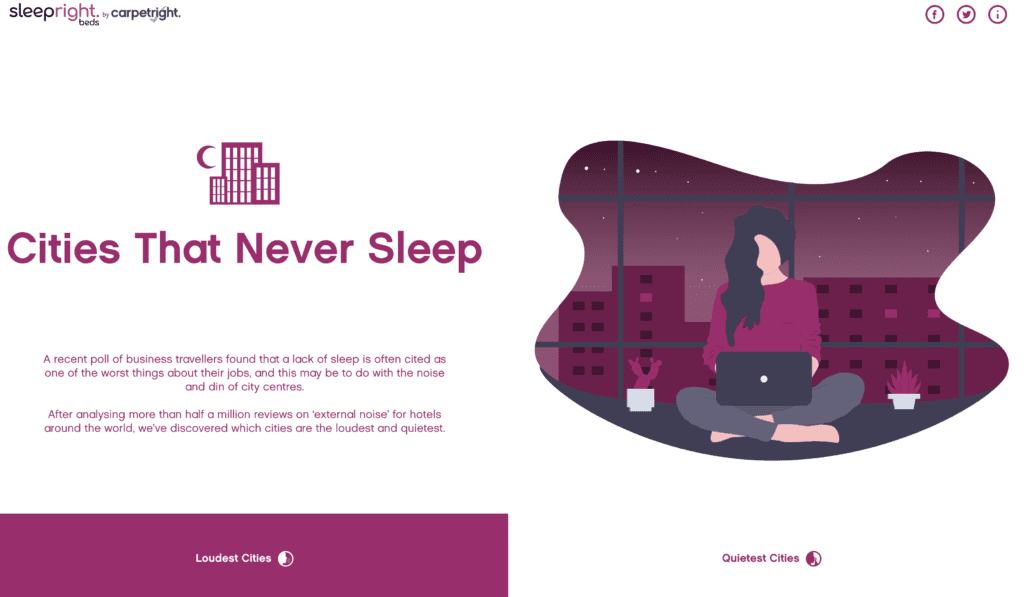
This asset has a whopping 85 referring domains and is incredibly interactive. It essentially breaks down the nosiest and loudest cities across the world, packaging it into a neat visual asset that makes for an interesting read.
What’s amazing is that they didn’t collect any of the data themselves, they simply found data that had already been collected, analysed it, created an angle, and reaped the rewards.
To be clear, any company can do this. You don’t need a huge research department that is collecting and analysing data 24/7. The data you need is already out there, you just need to find it and package it in a novel way.
Take Carpetright’s idea as inspiration. If you’re a smaller brand looking to improve your visibility, creating large assets such as this could be an effective way to generate more backlinks and more authority fast.
We Wanted to Dive Deeper…
Unfortunately, without access to Carpetright’s Google Analytics and Search Console, we can’t dive deeper into Carpetright and how they’re performing in terms of a UX and conversion point-of-view.
Despite this, as a lot can be inferred from a simple frontend analysis, as you can see above. Bear in mind a lot of what we found is based on what we’ve seen work with large household names, such as Dreams, Laura Ashley, and Shake That Weight. So, you can rest assured we know what we’re talking about.
If you’re looking to get a head-start online and want help from experts getting big results for the biggest brands, get in touch today for a free audit.
